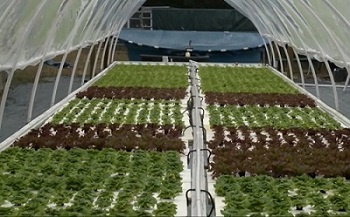Hydroponic gardening is gaining popularity as a way to grow fresh produce in a controlled environment. One of the most popular hydroponic systems is the strawberry tower, which is perfect for growing delicious strawberries. In this article, we will provide a step-by-step guide on how to build and maintain your own hydroponic strawberry tower.
Benefits of a hydroponic strawberry tower
There are several benefits to using a hydroponic strawberry tower to grow your own strawberries:
- Space-saving: Because the tower is vertical, it takes up less floor space than traditional horizontal gardens.
- Increased yield: The tower allows you to grow more plants in a smaller area, resulting in a higher yield of strawberries.
- Less water usage: Hydroponic systems use less water than traditional soil-based gardens, as the water is recirculated and not lost to evaporation or runoff.
- No weeding: Since the plants grow in a sterile medium, there are no weeds to contend with.
- No pesticides: Because the system is closed and controlled, you can avoid using harmful pesticides and herbicides on your plants.
- Fresh and delicious: Nothing beats the taste of fresh, homegrown strawberries!
Hydroponic Strawberry Tower
Step 1: Materials
Before you start building your hydroponic strawberry tower, you will need to gather the necessary materials. Here are the items you will need:
- A PVC pipe (4-6 inches in diameter)
- A PVC cap for the bottom of the pipe
- A PVC elbow joint
- PVC end caps for the top of the pipe
- A submersible water pump
- A plastic container (such as a storage bin or bucket)
- A sheet of foam
- Net cups
- Hydroponic nutrient solution
- Strawberry plants
Step 2: Building the Tower
Now that you have gathered your materials, it is time to build the tower. Here are the steps to follow:
- Drill holes into the PVC pipe using a 2-inch hole saw. These holes should be evenly spaced along the length of the pipe and be large enough to hold the net cups.
- Insert the net cups into the holes in the PVC pipe.
- Attach the PVC elbow joint to the bottom of the PVC pipe using PVC cement.
- Attach the PVC cap to the other end of the PVC pipe using PVC cement.
- Place the PVC pipe into the plastic container and fill the container with water until the water level is just below the bottom of the PVC elbow joint.
- Insert the submersible water pump into the container and attach it to the PVC elbow joint.
- Cut a sheet of foam to fit over the top of the PVC pipe and place it over the net cups.
- Cut holes in the foam to match the net cups.
- Fill each net cup with hydroponic nutrient solution.
- Place a strawberry plant into each net cup.
Step 3: Maintenance
Once you have built your hydroponic strawberry tower, it is important to maintain it properly to ensure your plants grow strong and healthy. Here are some tips for maintaining your tower:
- Monitor the water level in the container and add more water as needed.
- Check the pH of the nutrient solution regularly and adjust it if necessary.
- Keep the water temperature between 65 and 75 degrees Fahrenheit.
- Check the water pump regularly and clean it if needed.
- Trim any dead or damaged leaves from the plants.
- Harvest the ripe strawberries as they appear.
Tips for growing healthy and delicious strawberries
To ensure the best results from your hydroponic strawberry tower, keep these tips in mind:
- Choose a sunny location: Strawberries need at least six hours of sunlight per day to thrive.
- Monitor the pH and nutrient levels: Use a pH meter and nutrient testing kit to make sure the water is within the optimal range for strawberries (pH 5.5-6.5 and nutrient strength of 800-1200 ppm).
- Maintain the water level: Make sure the water level in the reservoir stays consistent and doesn’t get too low or too high.
- Provide proper ventilation: To prevent mold and other fungal growth, make sure the tower has good air circulation.
- Prune regularly: Trim off any dead or yellowing leaves to promote healthy growth and prevent disease.
- Pollinate by hand: If you’re growing strawberries indoors, you may need to pollinate the flowers manually using a small brush or cotton swab.
- Harvest when ripe: Pick the strawberries when they’re fully ripe and red for the best flavor and texture.
FAQs
Do I need any special tools to build a hydroponic strawberry tower?
No, you only need basic tools like a drill and a saw.
Can I use other plants in my hydroponic tower?
Yes, you can use a variety of plants in your tower, as long as they can grow in a hydroponic system.
How often do I need to check the pH of the nutrient solution?
It is recommended to check the pH daily or at least every other day to ensure it stays within the appropriate range.
Can I reuse the nutrient solution?
Yes, you can reuse the nutrient solution for several weeks, but it is important to monitor and adjust the pH and nutrient levels as needed.
How many strawberry plants can I grow in one tower?
The number of plants will depend on the size of your tower and the spacing of the net cups, but typically, a tower can hold between 20-30 plants.
Conclusion
Building a hydroponic strawberry tower is an excellent way to grow delicious strawberries year-round. By following the steps outlined in this guide, you can build your own tower and enjoy the benefits of hydroponic gardening. Remember to monitor your tower regularly and maintain it properly to ensure your plants grow strong and healthy.

